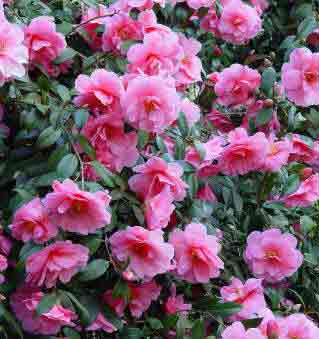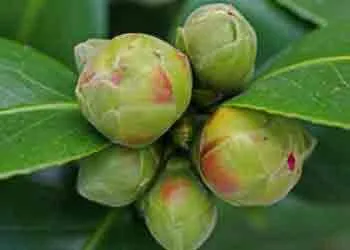Flowering Time of Camellias

It is possible to have camellias flowering from late autumn/early
winter, right through to the onset of spring or even early summer. Most
camellias are long flowered some more than others and all should
give at least a month of flower in all but the severest of weather.
The flower colour range is from purest white through all pink shades
and stopping at deepest crimson red. Flowers are rounded, and can be
single, semi-double or full double. In short there will be Camellia to
suit whatever you preference (other than blue!)
Flowers are generally 2 4 in across (sometimes as much as 5in), and
normally held towards the tips of the branches and lateral shoots -
often weighing slender branches down with their weight.
Foliage of Camellia
Rounded spear shaped dark green and glossy evergreen foliage,
normally terminating in a pointed end, makes it an attractive shrub
throughout then year, and is particularly good when acting as contrast
for plants with autumnal tints. The shrubs are generally
densely-foliaged though a few have a slightly open and loose habit.
Camellia Planting and Growing Position
Most camellias are happiest in semi or dappled shade. Many will grow
in a position where there is only minimal sunlight - such as the north
side of house or fence. Ideally though, a woodland or tree shaded
situation is best. As with many things gardening, there are exceptions
to the rule. Camellias are no different, in that one group - Camellia
sasanqua - will grow in a sunny situation (as well as in the normal
dappled shade areas).
Some Camellias will grow to 4-6 meters even more but most are
happy to settle in at around 2m or even less. Good pruning can help to
keep the shrub within bounds, but proper choice of position would be
preferable. Container grown Camellias rarely reach more than 1.5 metres unless you specifically pot and grow with larger in mind!
Camellias have a reputation for losing their flowers before they are
fully open. This is generally because they have been planted in a
situation where they are subject to sun in the morning during the winter
months. This does not harm the plant itself, but thaws out frozen flower
buds too quickly resulting in the buds dropping off the plant. Camellias
planted in a semi-woodland situation or in north facing aspect do not
normally suffer so. If grown in a large container, I always advise it to
be positioned on the north side of the house.
Camellias are excellent for growing in large containers, and can be
trained and pruned into pyramidal shape if need be. Containers are
particularly useful when living in a
lime soil area.
Problems with Growing Camellias.
Camellias will give many years of pleasure if you avoid the basic
pitfalls of planting in alkaline soil; growing in exposed situations;
Planting in full sun, and not allowing for the potential mature size.
Aphids
Camellias can suffer attacks from
aphids
assorted, and this generally results in unsightly
sooty mould unless dealt with promptly. Other than that, Aphids seem
not to be a life-threatening problem unless grown in a conservatory or
under glass.
Scale insects and
Vine Weevil beetle and larvae can be a problem with container grown
specimens in particular, and should be one of the first avenues of
inspection if plants seem unhealthy.
Leaves turning yellow (generally chlorosis) is normally a sign of
lime in the soil or with container plants, watering with tap water in
alkaline water areas.
Propagating Camellias
Camellias can be propagated by several types of cuttings - rarely
from seed. They can also be grafted by those with the know-how.
Leaf Bud Cuttings are the norm - taken in late
summer. A stem of the current season's growth is simply cut into
sections with just one leaf attached! Scrape the bark at the rear of the
leaf and bud - or just slightly removing a sliver. Apply Rooting powder.
These sections are then placed into a heated propagator in the normal
way, or inserted around the edge of a pot and enclosed with a clear
plastic bag until rooted. Do not let the cuttings suffer in the heat of
summer/autumn sun. Keep shaded.
Semi Ripe cuttings will also root as the above method, if you just
want to increase a few plants.
Alternatively, the cuttings can be kept in a cold frame until rooted.
Pruning Camellias
| Camellia
sasanqua Alba
Camellias are one of the few winter flowering shrubs that will respond to pruning if necessary. It is important to realise that the flower buds for the Camellia are formed in early summer, ready to flower in late autumn or winter a few months hence. Any pruning carried out should be done right after flowering, in order to allow the shrub enough time to produce new shoots and flower buds.
Late pruning will inevitably result in a winter season with few or even no flowers. Late pruning of Camellias and other winter flowering
shubs is one of the main causes poor or no flowers.
The shrub needs time through the spring and summer growing season to firstly produce new shoots and then produce the flower buds on those shoots ready for winter flowering. Flowers don't simply happen. They are a result of flower buds sometimes produced several months before actual flowering.
The most basic form of pruning camellias is simply dead-heading the
faded blooms which simply make the shrub look untidy. Dead-heading does
not prolong flowering as such, for as explained earlier, the flower buds
will have been formed long ago. However, with single flowered varieties
in particular, it can prevent seed setting. It takes energy to form
seeds and this will have to be diverted from the general growth if the
shrub.
The image shows quite clearly, a typical cluster of rounded
flowerbuds as the plant does into winter. these buds would have been
produced through July/august. leaf buds would normally be elongated and
pointed.
Pruning
is generally carried out in order to maintain a compact shape to the
camellia. Pruning is only necessary for this reason. If you are happy
with a lax, open habit maintained by some varieties, then no need to
prune for this reason.
pruning Camellias is not rocket science. You can simply trim
off any elongated shoots that you feel will eventually spoil the shape
of the shrub. Cut back the 'offending' twigs with a pair of secateurs to
just above a pair of health buds further down the stem. Do not cut back
too far, unless you really need to head the size back.
If your camellia has been neglected, or if you really want to
re-start with a smaller shrub, camellias respond quite well to
pruning hard or rejuvenation pruning. Do
this type of pruning as early in the spring as possible, and be prepared
for some robust shoots to emerge. these in turn may need shortening in
order to start a bushy framework once again.
The camellias response and happiness with being pruned, also makes
for good Container plant specimens. Formative clipping - with secateurs
- will allow you to train a pyramid shape - though not as formal as
attained by training Bay trees.
The single most important fact to bear in mind, is that if you want
flowers the following winter, then your pruning needs to be undertaken
immediately after flowering. If you are prepared to sacrifice flowers
for a year or so, then the Camellia can be pruned a little later, but
before the summer sets in proper.
Growing Camellias
|










